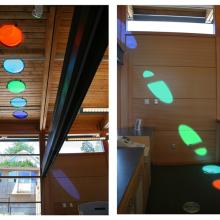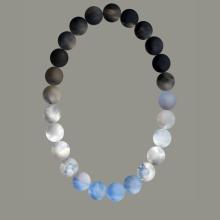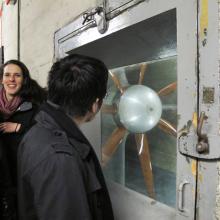Rebecca Cummins has long been fascinated with optics and the history of science and technology. This has impacted both her artwork and teaching, for which she has consulted physicists, astronomers, opticians, architects, and other specialists. Cummins’ installations have included a machine for making rainbows, a camera obscura journey through the center of the earth, and a variety of sculptural and photographic approaches to marking time. Her most public local piece is the Skylight Aperture Sundial at the Montlake Branch of Seattle Public Library, installed in 2006 and developed with advice from two University of Washington professors: Christopher Meek, Integrated Design Lab, College of Built Environments, and Woodruff Sullivan, Astronomy (with whom she co-taught a 2003 course titled “Where is Noon? Regarding Giant Sundials”).
Cummins, an associate professor in the Photomedia Program, had a busy schedule of special projects last year. She was invited to take part in the April 2010 “Moving Image Workshop” at the Getty Center, Los Angeles. Twenty-three artists, scholars, archivists, and collectors each presented their work or a discussion topic in relation to the archaeology of cinema and optical devices with a perspective toward future practices. Later that month, she presented at and participated in the Exploratorium’s “The Observatory: Optical Device Workshop” in San Francisco. Cummins returned to the Exploratorium—a museum of science, art and human perception—as an artist-in-residence for a week in November to consider future artwork/installations with the Observatory design team. The Observatory is a second floor transparent gallery planned as part of the Exploratorium complex being developed on the Embarcadero. During the summer, Cummins participated in The Long Walk, part of the 4Culture-funded Trails Project, and prepared for autumn exhibits. She had work in a group show titled Repercussions: Tides & Time at SOIL in Seattle during October. That exhibition was then mounted at the Sarah Spurgeon Gallery, Central Washington University, and Cummins gave a lecture prior to the opening reception in early November. From mid-October through early December 2010, she had multiple pieces in Steambot, a show at the Kirkland Arts Center developed in collaboration with four other artists. One work was a piece Cummins created with Rusty Oliver, titled Velotrope, which combined a zoetrope with a modified bicycle—the faster you peddled, the speedier the animation. She also showed a few pieces from the Great Couples in Art series, enlisting the optical illusion of figure-ground reversal in which one alternately sees a white goblet or double silhouette portraits. Images of the artworks shown in Steambot are in an online version of the exhibition’s catalog.
The new year has not slowed down for Cummins; in fact, her activities have multiplied. She is participating in an arts and science exhibition titled Forecast: Communicating Weather and Climate at the Washington State Convention Center, which opened during the 91st Annual Meeting of the American Meteorological Society in January and continues until 09 April 2011. Her work for that show, Sky Necklace: Seattle, Hourly, October 18, 2009, features 24 painted beads, each representing a view of the sky for every hour of the day in Seattle on that date. Other projects in 2011 include a presentation in an ARTspace session during the College Art Association Conference in New York City; another showing of Repercussions at Grand Rapids Community College Collins Art Gallery; a presentation titled “700 Million Miles an Hour and Other Phenomena” at the Society for Photographic Education Conference in March (this year’s conference has the theme of “Science, Poetry and the Photographic Image”); a one-week, SiCa-funded, spring workshop with Stanford University students on optical devices and sun tracings, accompanied by an exhibition of Cummins’ work and pieces created by the students; a lecture/demonstration/workshop as part of Tom Gunning’s “Seminar in the Moving and Projected Image” at University of Chicago’s Cinema and Media Studies program; co-chairing, with Professor Woodruff Sullivan, the national conference of the North American Sundial Society in Seattle; and preparations for an autumn solo exhibit at Vanderbilt University Fine Arts Gallery. The funding for her travel is either self-financed, covered by grants, or paid by other institutions.
With all these projects, has it been possible for Cummins to teach? The answer is a most emphatic “yes.” As part of a regular teaching load, she has been instrumental in developing a large version of “Basic Photography” (Art 140), which enrolls up to 150 students. This is part of an effort in the Art and Design Divisions of the School of Art to create courses that can serve larger numbers of students. She also has taught a Discovery Seminar version of this course for Early Fall Start, a program for incoming freshman students. During Winter Quarter 2011, Cummins has brought together some of her more unusual interests in a new course titled “Black Holes, Grey Matter and White Cubes: Visualizing Science” (Art 360).
In this course, nineteen students from Interdisciplinary Visual Arts, 3D4M, Photomedia, and DXARTS are being challenged and inspired by exposure to a variety of resources, both on campus and off, including visits to the Kirsten Wind Tunnel in the University of Washington Aeronautical Laboratory, the University of Washington Center for Environmental Visualization, and the National Oceanic and Atmospheric Administration’s Western Regional Center at Sand Point. The nature of Cummins’ artwork has made her acutely aware of the many resources available locally, and she is happy to share these with students. In her roles as artist and faculty, Cummins continues to move at the speed of light.








